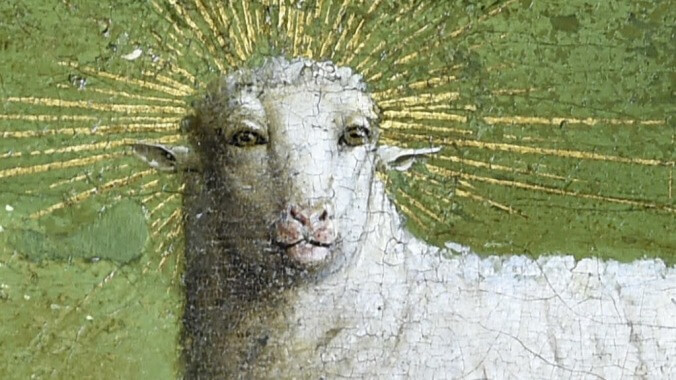Behold the awesome, unblinking gaze of the restored Mystic Lamb

Art restoration doesn’t always go as planned. Sometimes, the work in question is simply cleaned up and left looking pretty much the same as it was before anything was done to it. In other cases, the restoration process ends up doing something a lot more drastic—like, say, turning a fresco of Jesus Christ into a portrait of a shocked monkey.
While we may never see the likes of something like “Monkey Jesus” again in our lifetime, the recently completed restoration of Jan and Hubert Van Eyck’s 15th century Adoration Of The Mystic Lamb features a sheep glow-up that drastically changes the impression it gives off.
A before and after comparison tweeted by @frajds shows the difference pretty clearly. On the left, the original Lamb Of God looks gently (if a little menacingly) forward, its features hazy. On the right, Lamb 2K20 stares intently outward through piercing, almost human eyes. The vague impression of extra ears is gone and its face tapers into a weirdly distinct muzzle that seems about to open with words of divine wisdom or just a casual, “Hey, guys!”
The original Lamb, which is part of the centerpiece of the entire Ghent Altarpiece’s lower register, was revealed after a three-year, multi-million Euro restoration project removed additional layers of paint added to the Altarpiece during the 16th century. The restoration’s leader, Hélène Dubois, described discovering the face as “a shock for everybody—for us, for the church, for all the scholars, for the international committee following this project.” This is only natural when you imagine a group of people delicately removing the newer layers bit by bit only to look up from their work and find the new, extremely intense Lamb staring directly into their being and sort of puckering up for a kiss.
The contrast between old and new is strong enough that it’s inspired not just critical reappraisal of a foundational work of art, but also a fledgling meme.
For those who prefer the more passive face of the Lamb as we’ve known it for so many centuries, it’s time to move on and embrace the true face envisioned by the Van Eycks. There is no going back, outside of historical reference, to anything other than a Messianic staring contest when looking upon the Ghent Altarpiece. Unless, that is, we look to the model provided by @yayben and decide, like the 16th century painters who covered the Lamb’s appearance in the first place, to once again soften the commanding work once more.
Send Great Job, Internet tips to [email protected]